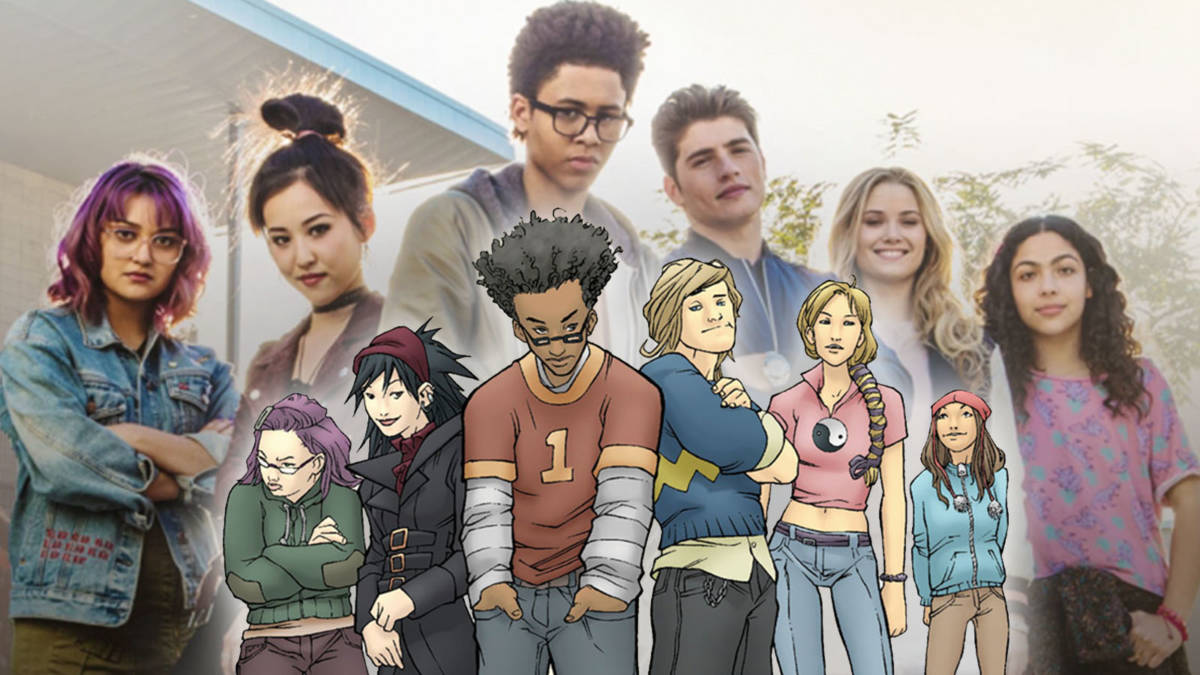On the heels of its renewal for a thirteen-episode second season, the tenth and final episode of Runaways‘ first season premiered on Hulu last week. The latest entry on the TV side of the Marvel Cinematic Universe, Runaways is the story of six teenagers (and one genetically engineered dinosaur) who stumble onto evil lurking beneath the idyllic surface of their upper-crust Los Angeles lifestyle.
Childhood friends Alex, Karolina, Nico, Chase, Gert, and Molly discover that for years their parents, under the guise of charity organization PRIDE, have been kidnapping and sacrificing runaway teenagers for a dark purpose beyond their understanding. With no one to trust but each other, they’re forced to repair their fractured relationships, come to grips with their newly discovered abilities, and work together to put a stop to their parents’ machinations.
Leaving the high-flying adventures of the Avengers and the gritty crime drama of the Defenders on the streets of New York City, Runaways heads west to sunny California. Described by Marvel TV head Jeph Loeb as “the O.C. of the Marvel Universe,” it’s no surprise that the creators of that beloved teen drama were brought in to helm Runaways. The O.C. and Gossip Girl creators Josh Schwartz and Stephanie Savage tap back into their inner teenagers to deliver a show that’s more drama and mystery than superheroics. This is a new coast, a new network, and a whole new tone for Marvel. For a property like Runaways, it works like a charm.
Runaways‘ dark narrative is set against the bright backdrop of picturesque LA neighborhood Brentwood. The sunny exteriors of the kids’ mega-mansions and posh high school create a striking contrast to the otherworldly darkness they discover bubbling underneath the surface. The entire show carries with it a grim energy, like the quiet gloom of a too-hot summer day, haze rising off the pavement and obscuring what’s on the horizon.
This tone is set largely by Runaways‘ fantastic title sequence – an oft-underappreciated element of a show, especially since Netflix gave us a button to skip them entirely. Perhaps redundant while binging, but when watching a show week to week, a good title sequence is important to establish the tone of the story and re-immerse the viewer in the world of the the show. Runaways‘ title sequence is a trance-like montage mostly devoid of people, each shot capturing desolate locales, abandoned objects, or solitary street art reminiscent of the characters and their powers. Moody, atmospheric theme music accompanies shadows that stretch ominously across sunlit scenes. The sequence is somehow bright and bleak simultaneously, perfectly setting the tone for each episode.
With a cast of in-over-their-head teenagers, love triangles, infighting, and general angst can’t be too far behind. That’s not to say the show is overly dour. True to form, Schwartz and Savage fill their corner of the Marvel Universe with all of the snark you’d expect from teenagers, especially in a Marvel property. Schwartz and Savage play to their strengths, crafting funny and believable dialogue that makes the Runaways feel like real kids rather than empty stock characters.Though all of the typical high school archetypes are represented – nerdy Alex, good girl Karolina, goth Nico, jock Chase, social justice warrior Gert, and her impatient kid sister Molly – they all come across as realistic teens with distinct personalities. The relationships between the Runaways, as well as with their parents, form the emotional core of the show.

Nearly as much screen time is dedicated to the Runaways’ parents as it is to the kids themselves. The members of PRIDE are just as complex and diverse as their children. Where they could easily have been generic, mustache-twirling supervillains, the show manages to present them all as fully-formed and even sympathetic. Their conflicted feelings about their involvement in PRIDE and their clear love for their kids make them relatable to the audience. Watching the story unfold from both perspectives adds an extra layer of depth to the show.
Visually, Runaways leans in a more grounded and realistic direction. The Runaways’ discovery of their powers is a slow burn, so the show uses fantastic and supernatural elements only sparingly. What we do see works well, though Karolina’s rainbow glow could use revisiting. The show’s CGI heavy-lifting appears to have been focused on Gert’s psychically-bonded Deinonychus Old Lace, who looks just as amazing as I’d hoped. If Inhumans proved anything, it’s that bad special effects break immersion. Runaways avoids that trap by keeping the CGI to a minimum.

Unfortunately, that translates to a general lack of action in what’s meant to be, at least in part, a superhero show. While we get teases of all the Runaways’ powers, we never see them fully cut loose. The major confrontation in the season finale is a bit of a let down, and as good as Old Lace looks, we don’t get to see her do much. More action might have run counter to the story the show was telling, or it may simply have been due to budget constraints. Here’s hoping we get to see some serious superheroics and good-old-fashioned Deinonychus violence next season.
Runaways is smartly written and true to its roots, doing justice to some of the most celebrated new creations at Marvel since the turn of the century. Its characters are well-developed, its settings are eye-catching, and its story is compelling. Runaways‘ tone is familiar yet unique, blending the teenage drama and humor of shows like The O.C. with elements of mystery, fantasy, and science fiction. This first season is a strong introduction to the Runaways’ world, and I look forward to seeing where they run next.
Some of the coverage you find on Cultured Vultures contains affiliate links, which provide us with small commissions based on purchases made from visiting our site.

